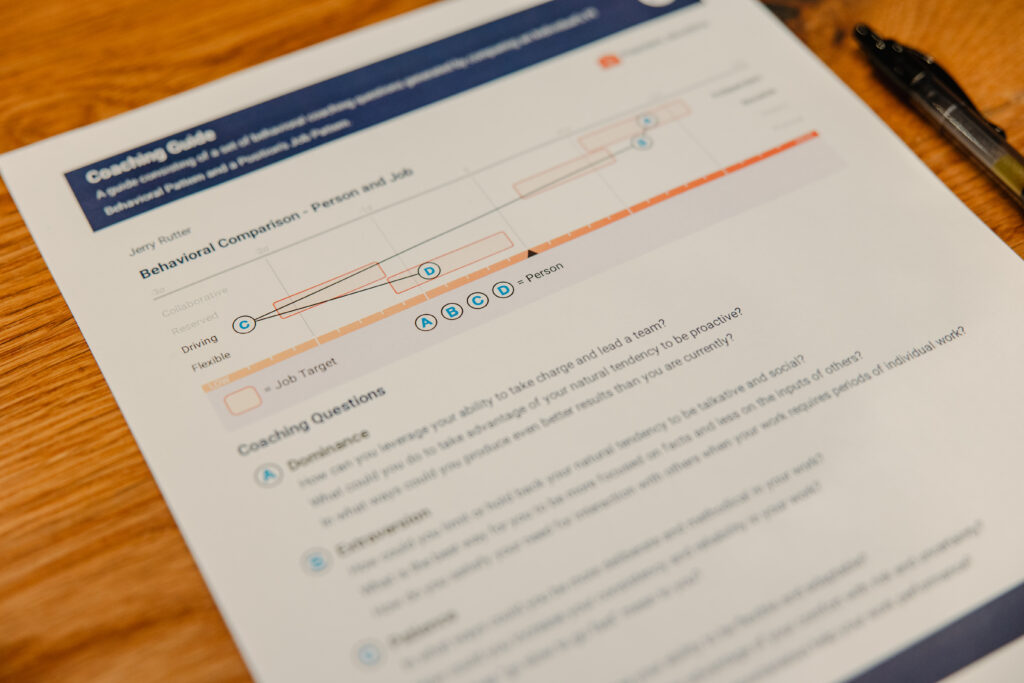
Best Practices for Using the PI Coaching Guide
How do you transform a good performer into a great one?
Within the landscape of human resources and talent development, assessments like the Predictive Index (PI) Behavioral Assessment have emerged as invaluable tools. The Behavioral Assessment uses over sixty-five years of research and algorithmic data to offer deep insights into an individual’s natural strengths and communication styles. These insights pave the way for success in various roles. The PI Coaching Guide, particularly, stands out as a tool for developing leaders and tackling leadership challenges. Here are five best practices when using the PI Coaching Guide.
Understanding Strengths: The First Step to Success
Before diving into the nitty-gritty of coaching, it’s crucial that employees receive and comprehend their PI results. Recognizing one’s strengths is not just enlightening; it’s empowering. This sets the stage for both personal and professional triumphs. The best way for an employee to gain self-awareness is through a readback of their PI results. With a one-on-one debrief, the employee will have space to reflect and ask questions about their results, before jumping into a development conversation.
One Step at a Time: The Art of Focused Development
In coaching, less is more. The key to effective coaching is not to overwhelm, but to target desired behavior. Selecting just one development area at a time allows for a more concentrated and impactful approach. This laser focus fosters deeper understanding and more significant improvement, as opposed to a scattered effort in multiple directions. In addition to just choosing one item, the focus of development conversations should be on elevating high performers, not troubleshooting performance issues (that requires a different kind of conversation).
Creating a Dialogue: The Power of Participation
True coaching is about creating a dialogue. Have a conversation where the employee is not merely a passive recipient but an active participant in their development plan. Employees need to be involved, to own their growth journey. This is where real development happens.
Here’s how to make your coaching conversation a dialogue, not a monologue:
- Share expectations for the conversation in advance.
- Ask one question at a time. Then, listen.
- Encourage your employee to share their own ideas and solutions (don’t choose for them!).
- Commit to one action item at a time.
By not spoon-feeding solutions, you’ll encourage independent thinking and problem-solving (essential traits for any high performer). This empowerment is the cornerstone of talent optimization.
Repetition, Repetition, and Did We Mention Repetition?
The beauty of the PI Coaching Guide lies in its versatility and repeatability. Addressing different areas over time, with repeated use, not only reinforces learning but also helps in uncovering new facets of an individual’s capabilities. Leaders can use the questions from the Coaching Guide during monthly development conversations, quarterly performance reviews, or regularly scheduled check-ins. This repetitive practice ensures continuous improvement and adaptability.

Addressing Challenges: Turning Managers into Leaders
One of the most significant challenges in leadership is time – time to understand, time to develop, and time to coach effectively. The PI Coaching Guide addresses this by providing customized recommendations that are specific to the individual and their job demands. It offers insights in minutes, not days.
Some managers struggle knowing how to develop their employees. With the PI Coaching Guide, you don’t have to guess. Lean on the customized questions and let the conversation do the heavy lifting. All you need to do is point north, ask thoughtful questions, and provide support along the way.
Embracing the PI Coaching Guide
What sets the PI Coaching Guide apart is its specificity and relevance to individual performance. It’s not a one-size-fits-all solution, but a tailored approach to development. This unmatched coaching capability requires minimal time and effort from the leader, yet yields significant developmental impacts.
In conclusion, the PI Coaching Guide is more than just a tool. It helps leaders to not only understand their team members better but to guide them effectively towards greater heights. By embracing this guide, leaders can ensure that their high performers not only maintain their momentum but also reach new peaks of performance and job satisfaction.
In a world where talent optimization is key, the PI Coaching Guide stands out as an essential asset for any leader looking to develop their team and overcome leadership challenges. It’s not just about managing; it’s about inspiring, developing, and leading.
Start Your Journey to Organizational Excellence
Begin your journey with MindWire by your side. Contact us today and let’s discuss how to elevate your business together.

